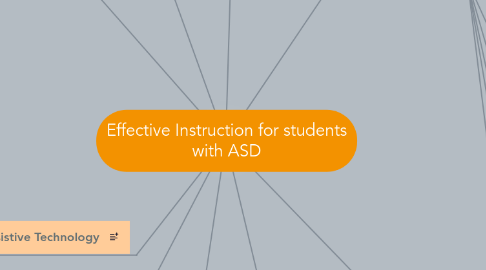Effective Instruction for students with ASD
por Laurel Mouland


1. Assistive Technology
1.1. Technology can be used by students to provide alternative methods to access information, demonstrate and reinforce learning, and interact with others
1.2. Technology can be used by adults/teachers as a tool to support the teaching and learning process
1.3. a student’s specific technological needs be evaluated and that the use of assistive technology be carefully planned
1.4. The potential benefits of assistive technology for individual students should be considered from a multidisciplinary and cross-curricular perspective
1.5. The support that is provided through the use of assistive technology will change over time for a student and may vary across activities
1.6. Ongoing monitoring of students’ needs and use of assistive technology is important to determine if the technology is being used effectively and is providing the student with the intended support
1.7. assist with communication challenges
2. Structured Learning Environment
2.1. predictable
2.2. to know what is expected of them in specific situations, to assist them in anticipating what comes next, and to learn and generalize a variety of skills
2.3. Rules and expectations should be clear and consistent and include specific information regarding the expectations for appropriate behaviour
2.4. consistent seating arrangement
2.5. everything has a place
3. Applied Behaviour Analysis (ABA)
3.1. ABA is an effective approach to understanding and changing behaviour, and teaching new skills
3.2. the behaviour(s) to be changed are clearly defined and recorded, and the antecedents and reinforcers that might be maintaining an undesirable behaviour, or that could be used to help develop alternative or new behaviours, are analysed
3.3. ABA is used according to the individual needs of each student, and may be applied to developing academic skills or behaviours related to social skills, communication, or self-care
3.4. The ultimate goal of using ABA methods is the generalization of the learned skills and behaviours to other settings and situations
3.5. Teaching Strategies used: prompts, modelling, reinforcements, task analysis, forward chaining, backward chaining, discrete trail training (DTT), shaping,
4. Behaviour Management
4.1. collaborative team problem-solving process
4.2. consistent
4.3. consider the student’s behaviour across various situations, and how to manage behaviours that arise in different settings and circumstances during the day
4.4. ongoing process with definable steps
4.5. ABA is an example of an approach
4.6. Completing an FBA ( functional behaviour assessment)
4.6.1. define targeted behaviours
4.6.2. analyse data
4.6.3. develop a hypothesis about the function of the behaviour
4.6.4. Do a functional analysis to test the hypothesis
4.6.5. Develop a behaviour support plan
4.6.6. Monitor progress and identify alternative strategies
5. Social Skills
5.1. get peers involved to help teaching social skills
5.2. create a level of awareness about ASD
5.3. In some cases, it is appropriate to work towards building eye contact during social interaction, if only for short periods
5.4. Individuals with ASD generally have difficulty imagining how other people may be feeling in a situation or forming hypotheses about what others may be thinking
5.4.1. direct teaching
5.4.2. ongoing mentoring
5.5. teach greetings directly
5.6. Social scripts (see “Social Scripts” in the “Strategies to Facilitate Social Understanding” section below) can be a very useful strategy to help students know the expectations of how to enter a play situation or how to ask someone to play
5.7. Sharing and turn taking are skills that initially may be best taught directly in a quiet, non-distracting environment
5.8. teach waiting using specific skills and strategies (e.g. schedule, first... then board, etc.
5.9. teaching students with ASD the specific skills that they will need for various activities and games, we enable students to enter into activities with a foundation of information and skills that they can apply to situations, and to be as independent as possible
5.10. Social scirpts
6. Visual Support
6.1. When using visual supports pair them with spoken language so students begin to attach meaning
6.2. Visual supports consider the preference and strength of individuals with autism to process non-transient and visual-spatial information.
6.3. Make visual supports age appropriate. Consider the size and portability of the visual as well as the kind of visual symbols you use
6.4. Take all school settings into consideration.
6.5. Using pictures allows us to communicate effectively with the student without adding to their stress.
6.6. Visual supports promote independence by providing visual cues which can eventually be used by the student for self-prompting
6.7. support oral language
6.8. make concrete
6.9. give students choice/voice
6.10. Examples: schedules, mini schedules (e.g. for getting ready for recess), break card, finished card, contract, reminders of rules, etc.
7. Differentiate Instruction
7.1. The content: The depth or breadth of the information or skills to be taught.
7.1.1. instructions
7.1.2. task expectations
7.2. The processes: The instructional approaches used with the student, as well as the materials used to deliver or illustrate the content.
7.2.1. groupings
7.2.2. support provided
7.2.3. time frame
7.2.4. materials and resources
7.3. The products of the learning situation: What the end product will be or look like. This product may be tangible (a worksheet, project, composition), a skill that has been acquired, or knowledge that has been gained.
7.3.1. assessment
7.3.2. task expectations
8. Sensory Considerations
8.1. It is important to be aware of the sensory preferences or sensitivities of a student and to determine possible elements in the environment that might have an impact on a student’s learning and level of anxiety
8.1.1. Some students are very (“hyper-”) sensitive in one or more sensory areas and may be more comfortable in environments with reduced levels of sensory stimulation
8.1.2. Other individuals are under (“hypo-”) sensitive and seek enhanced sensory experience
